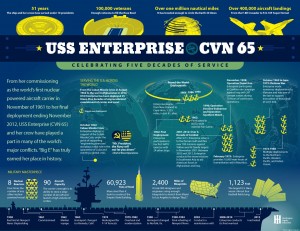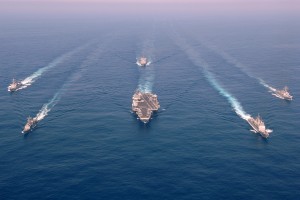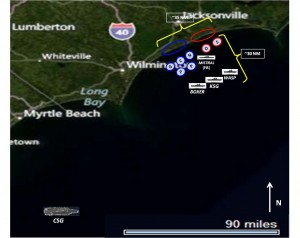2012-12-02 by Robbin Laird
The ceremony to declare the USS Enterprise inactive was held yesterday.
After a glorious career, and after shaping many innovations in Naval history, the USS Enterprise enters into history.

It is an end of an era, but a new one is dawning in US maritime history.
The christening of the USS America earlier this year was the other event, which correlated with the retirement of the USS Enterprise, provided the twin pillars of the future.
Eventually, the USS Ford will “replace” the USS Enterprise.

But it is an entirely new ship which when combined with kinds of assets already planned for the USS America can shape the next revolution in US maritime operations.
If the Ford were to be equipped as if it was the USS Enterprise, the entire point of the historic transition would be lost.
As I wrote earlier about the USS America:
It is not often that a new ship of the line is christened. And when it is, thoughts of how it might be used, where it might operate and how it might make new naval history are part of the excitement.
This was clearly evident at the christening of the USS America, the fourth ship of that name, in Pascagoula, Mississippi on October 20th.
This ship is not only the lead ship in a new class but will integrate the newest aviation of the USMC-USN team aboard a single operational platform at sea.
It will operate F-35 Bravos, Ospreys and CH-53Ks in the years to come. And the first ship will operate out of San Diego, and be part of the Pacific century.
Not far away, F-35 Bravos are being prepared for action in Eglin AFB. And in a confluence of events, two new F-35Bs landed at Eglin – one British and one USMC – the day before the christening.
Although called an LHA, it is not. Rather than being a Landing Helicopter Assault ship, it is flagship for 21st century operations. And these operations will be shaped by the need to operate at greater distance, and to strike with aircraft with significantly greater capability than the aircraft they are replacing.
The Osprey and the F-35 Bravo can operate at greater distance, speed and lethality than what they are replacing. The 360-degree aircraft – the F-35B – will provide along with its sister assets a change as big as that for which Admiral Sims and Admiral Halsey planned for with the introduction of the original aircraft carriers prior to World War II.
http://defense.aol.com/2012/07/16/what-the-cno-was-really-saying-about-the-future-force/
The future will deploy soon, and rethinking its impact on the fleet and re-shaping the entire concepts of operations for the Pacific century is upon us.
https://www.sldinfo.com/special-report-on-crafting-a-new-pacific-strategy/
And the good news is that many of our allies are joining us in this approach in other parts of the world, notably the Italians and the Brits are adding F-35Bs to their warships and may well add Ospreys in the future.
https://www.sldinfo.com/the-italian-f-35-faco-a-key-asset-in-the-global-f-35-support-system/
Ironically, the USS Enterprise, in its final tour, participated in the transition as a key element participating in Bold Alligator 2012.
As the Enterprise moved away from the assault phase, the large deck amphibious ships played the direct air assault role presaging an element of the historical transition.
https://www.sldinfo.com/re-thinking-maneuver-warfare-from-the-sea/


